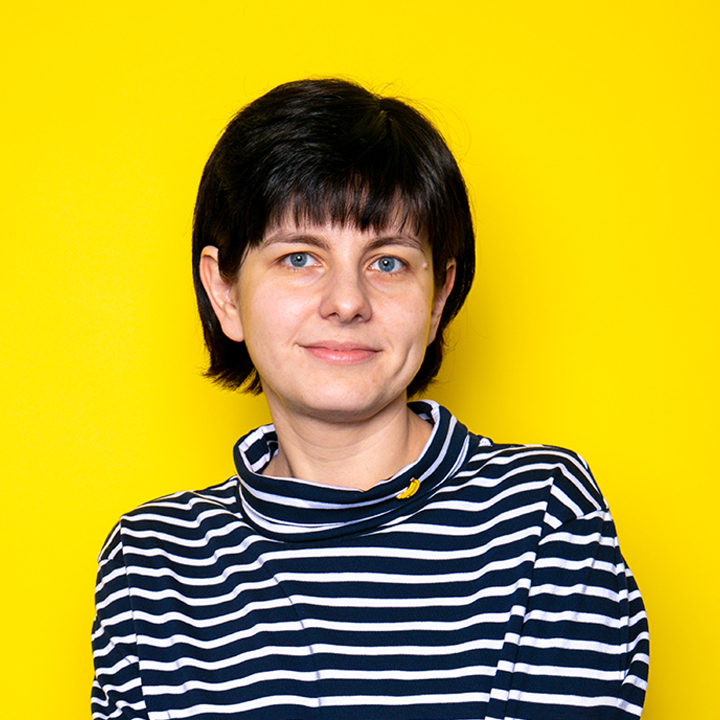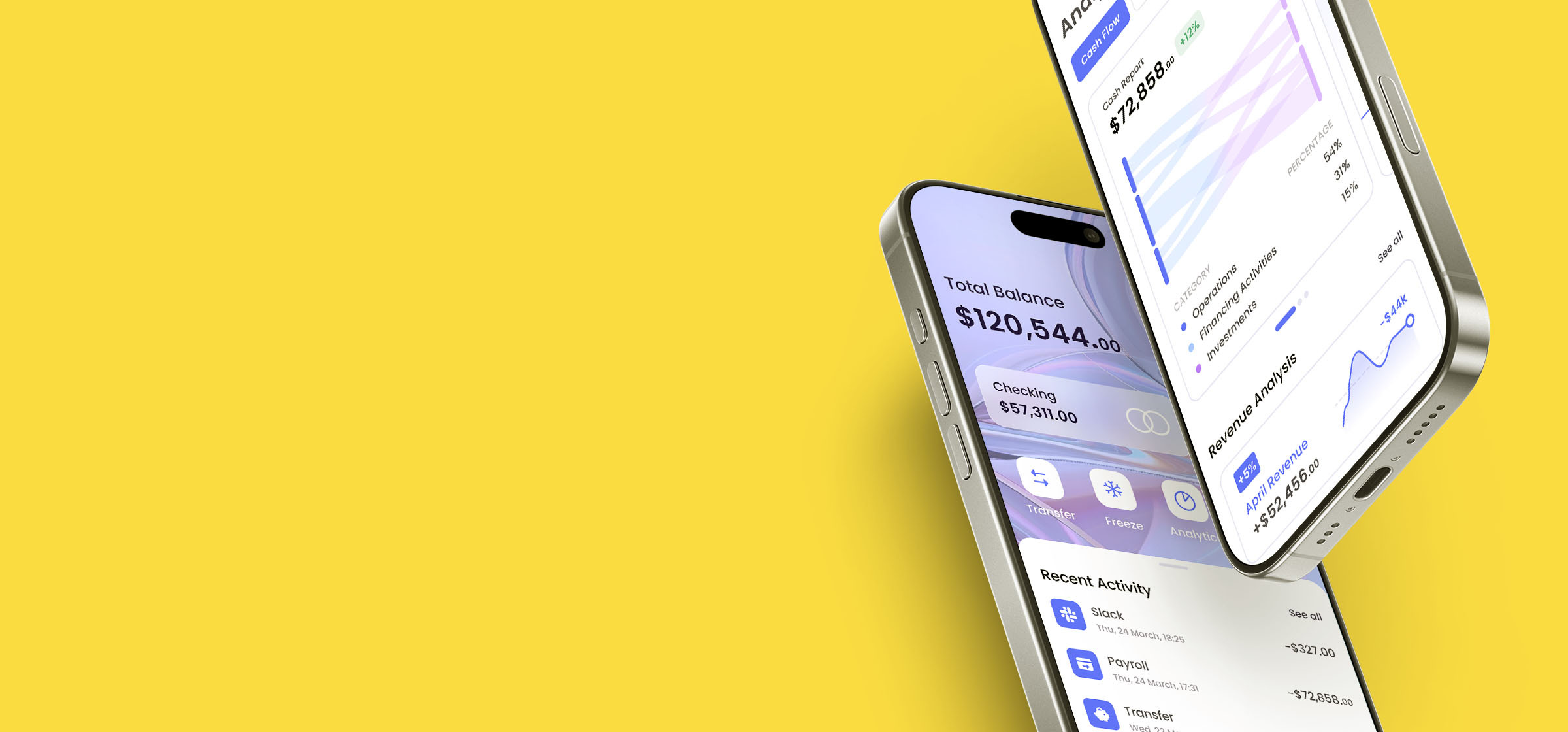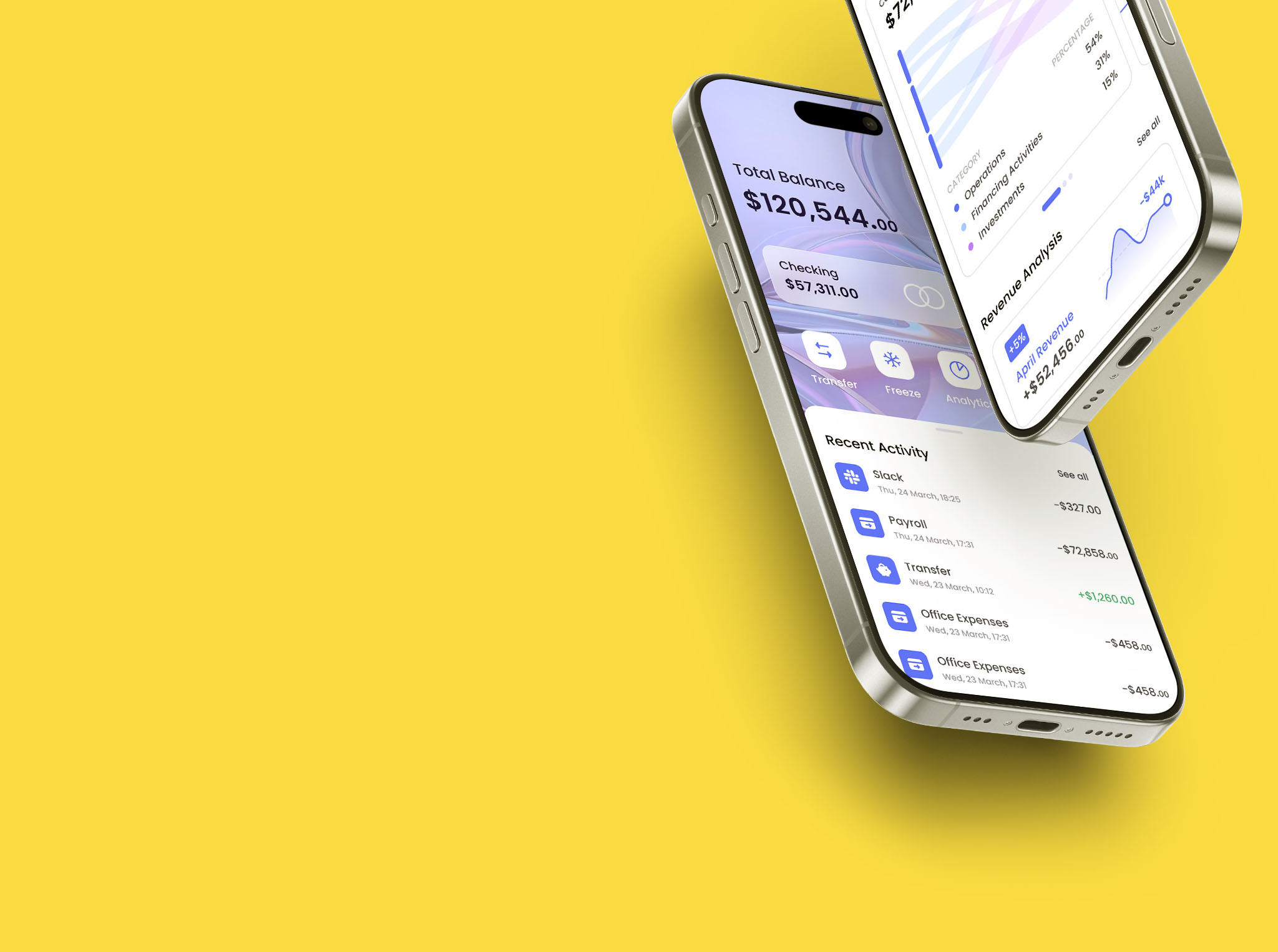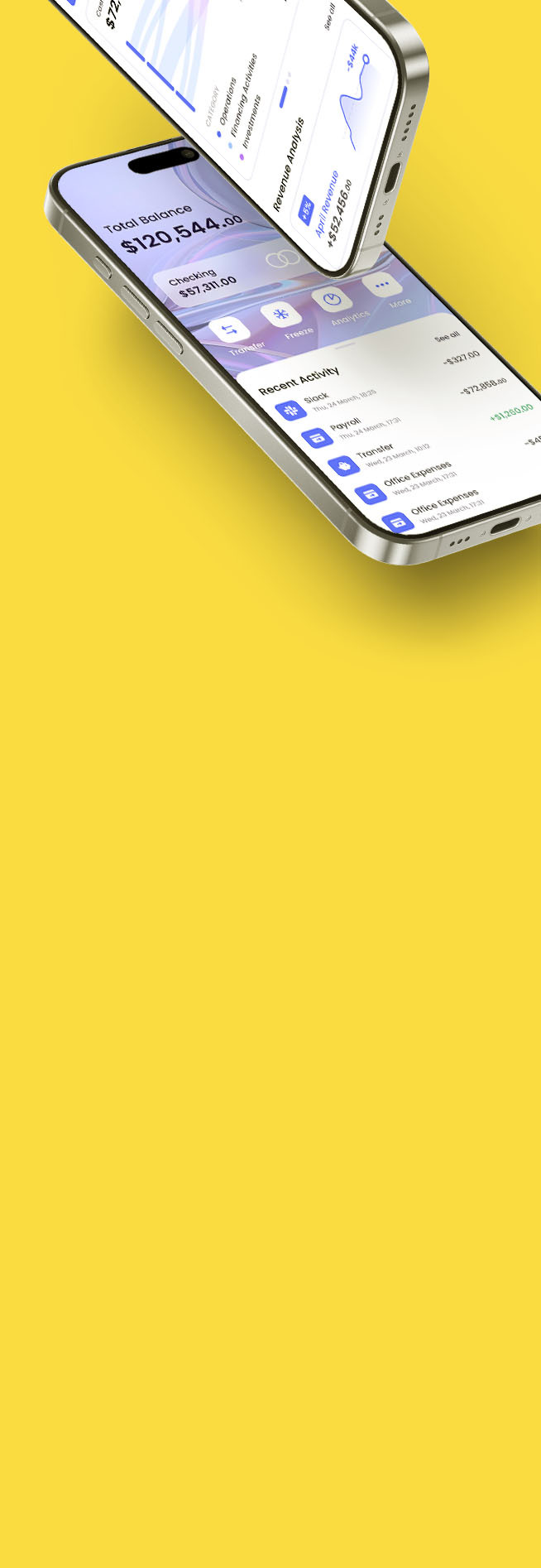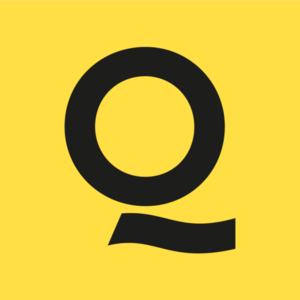Product Design Process: 10 Steps
Looking to
upgrade your product’s UX — or design something from scratch?
We don’t just write about design processes — we implement them step by step to turn your idea into a product users love.
Not sure where to go next? With 19 years in UX, we’re here to guide you — every step of the way.
- What is Product Design?
- Product Design Elements
- Requirements for Product Design
- Objectives of Product Design
- What is the Process of Product Design?
- Ten Steps of the Product Design Process
- How to Evaluate Product Design?
- Changing/Modifying Your Product Design
- Mistakes to Avoid
- How to Improve Your Design Process
- Finding the Design Solution
- Product Design with Qubstudio
- Conclusion
Ever considered why people choose the software products they do? Well, among other things, product design plays a pivotal role.
For example, Airbnb’s success is largely attributed to its user-centric UX/UI design. The platform’s simple navigation, visually appealing layout, and streamlined booking process significantly improved user experience, leading to increased user engagement and trust.
How do you implement a digital product design that captivates your customers? Spoiler alert: the answer is that it largely depends on your strategy. If you’re curious about what the design process entails and how to approach it effectively, this article is for you.
What is Product Design?
Software (or digital) product design is the process of envisioning what a website, mobile app, or any other digital product will look like and how it will function.
The lion’s share of this process takes place before implementation begins. It may involve dozens of professionals, including graphic designers, UX designers, animators, marketing specialists, business analysts, user behavior researchers, and more. It’s a complex multistep process at the junction of engineering, management, and graphics.
Product Design Elements
Formally, product design can be divided into three fundamental components: Appearance, Functionality, and Quality.
To ensure that a product not only looks good but also functions intuitively and efficiently for end users, software solution design principles encompass both the user experience (UX) and user interface (UI):
- UX design focuses on understanding user behaviors, needs, and motivations. It involves activities like user and market research, creating user personas, wireframing, prototyping, and conducting usability testing. The goal is to create a seamless and enjoyable user journey, ensuring that the product is intuitive and solves users’ problems effectively.
- UI design deals with the visual elements of the product. It includes the design of interfaces, layouts, typography, colors, and graphical assets. UI designers aim to create an aesthetically pleasing and consistent look and feel that complements the overall user experience.
In essence, software product design merges the principles of UX and UI to ultimately create a solution that ensures a high level of user satisfaction and engagement.
Requirements for Product Design
The requirements for product design all depend on the chosen target audience. There are two options.
1. The first is when the product is designed for the widest possible audience, and it is almost impossible to determine who exactly will use it. For this reason, the requirements are rather “blurry”. For example, the product must be compatible with the latest versions of popular operating systems, be compact, work quickly, solve user pain points (an obvious requirement), etc.
2. The second option implies the existence of clear customer requirements for product design (as a rule, they are presented in the form of requirements specification). Usually, the development company needs to submit several wireframes of the possible design that would correspond to all requirements, in order for the customer to choose the option they like most.
Objectives of Product Design
When it comes to designing a software product, the objectives revolve around creating an experience that fulfills business goals and users’ needs, both of which can vary from product to product.
Still, some objectives are universal:
- User satisfaction. The product must provide a user experience that meets or exceeds user expectations.
- Usability. The product must be easy to navigate, enabling users to accomplish tasks seamlessly and efficiently.
- Accessibility. The product must provide an equally seamless experience to all users, regardless of their abilities or limitations.
- Engagement. The product’s interface should captivate users and encourage continued interaction.
- Consistency. All design elements and interactions with the product must be uniform to ensure ease of use.
- Alignment with business goals. The design must support your business objective, whether it be driving sales, increasing user retention, or something else that enhances your business.
- Visual appeal. An interface must be aesthetically pleasing to garner a positive perception and emotional connection with users.
- Performance. The product must load quickly, operate smoothly, and function equally well across different devices and platforms.
These objectives collectively contribute to the creation of a digital product that not only looks great but also functions seamlessly to meet user needs and align with the goals of the business or organization behind it.
Achieving these objectives is impossible without a well-thought-out design strategy. Let’s see what that entails.
The Main Steps in Developing a Design Strategy
A robust strategy that efficiently steers your design process in the right direction doesn’t appear out of nowhere. It requires effort to create a strategy that takes all the essential objectives into consideration.
Whether it’s a complex software system or product page design, the process involves the following steps.
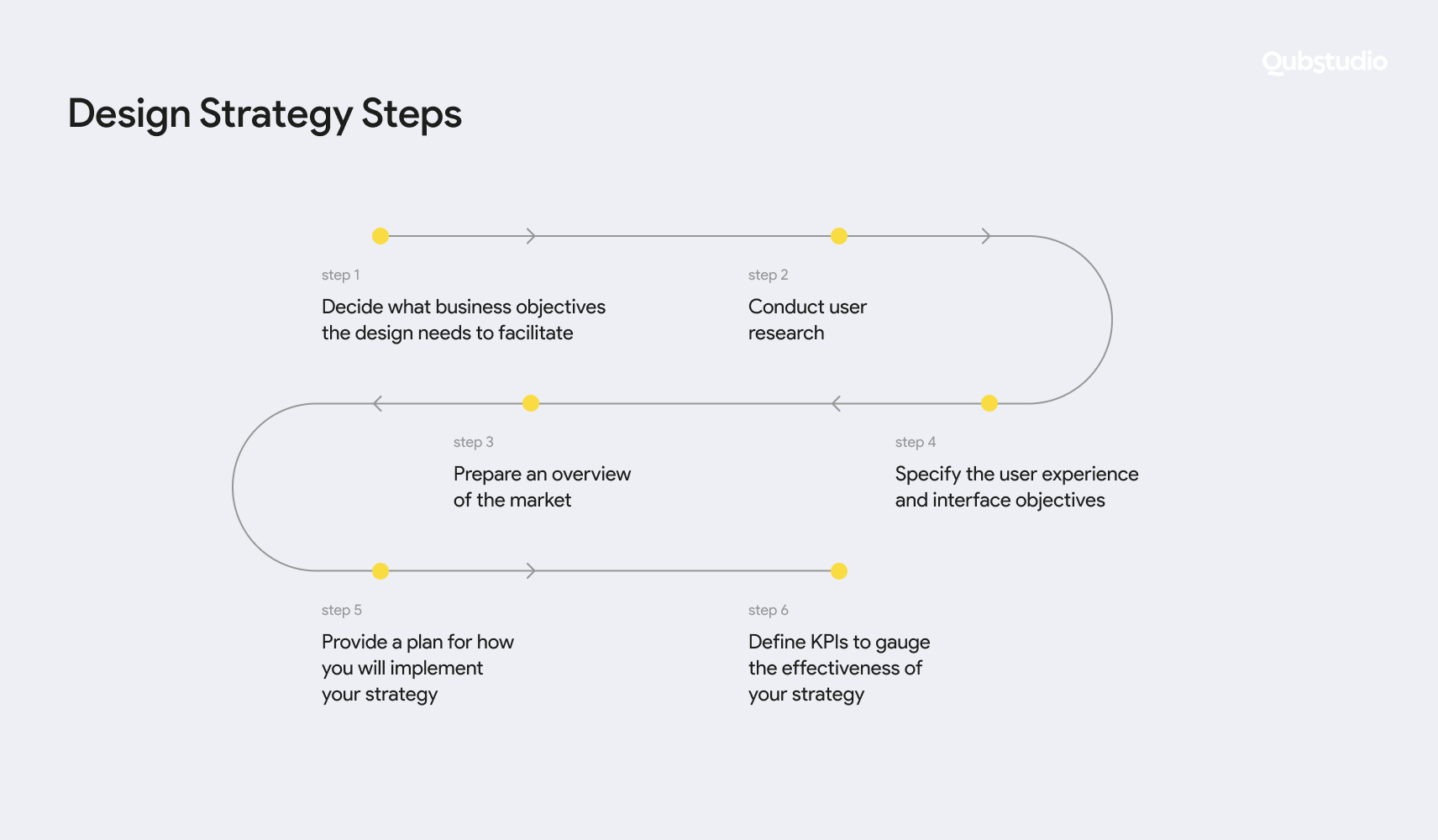
- Step 1. Decide what business objectives the design needs to facilitate. For example, if you’re creating a new software product, your business goal might be getting traction with the first user. Meanwhile, upgrading an existing software product might involve a goal like increasing sales, customer retention, or expanding into new markets.
- Step 2. Conduct user research to outline the needs, preferences, expectations, behavior patterns, and other important details about your target audience.
- Step 3. Prepare an overview of the market that includes key industry trends and an evaluation of competitors.
- Step 4. Based on your business goals, user needs, and market analysis, specify the user experience and interface objectives of your design.
- Step 5. Provide a plan for how you will implement your strategy. Include tasks, milestones, timelines, and the resources you’ll need (experts, technologies, and budget).
- Step 6. Define KPIs to gauge the effectiveness of your strategy.
A detailed strategy is the foundation of your design process. However, it’s only part of it. So what does the entire design workflow look like?
What is the Process of Product Design?
In general, there are 5 main product design phases:
- Discussing plans for launching a new product within the team, brainstorming;
- Defining pain points (desires) of the consumer and solutions for their elimination (achievement);
- Developing strict product requirements (documenting technical specifications);
- Splitting the product implementation process into iterations;
- Testing and modifying the created solution on the basis of real usage and target user experience.
Ten Steps of the Product Design Process
In order to consistently implement all the above five phases, we have developed a universal list of steps of the product design process and outlined them below.

1. Brainstorming
The first step in designing a product is brainstorming, which appeared in 1953 in the United States. As a rule, two groups are created for its implementation. The first group includes people who generate ideas to solve the problem. The second group consists of a “commission” that deals with the processing of the proposed ideas.
Brainstorming consists of three phases:
- Definition of the problem. In particular, you must announce the problem (in this case, the need to create the “right” product design) and select participants for both teams.
- Idea generation. This stage involves the most creative approach. Participants of the brainstorming voice every idea they can imagine, however crazy it may sound. Here, quantity is important, not quality. Therefore it is necessary to be guided by the following rules:
- generate as many ideas as possible, without any limitations;
- even the most absurd and non-standard ideas should be considered;
- ideas can and should be combined and improved;
- no criticism is allowed – at this stage, ideas should not be evaluated in any way.
- Selection of the most viable ideas among proposed. In this step, appreciation and criticism are welcome. This stage is usually conducted by the second team.
2. Defining the Product
After brainstorming, when all the viable ideas for the future product are chosen, you need to highlight a certain number of general expectations (requirements) for its implementation. As a rule, the output is a fairly abstract list, the task of which is not to form an exact guideline on the development, but rather to determine the directions for the further team activities.
3. Conducting the User Research
Organizations that prioritize ongoing CX and UX research are better positioned to develop user-centric products, drive business growth, and maintain a strong foundation for innovation in product design. Research implies several aspects: market research to define the presence of competitors, the definition of trends, the assessment of the product’s prospective longevity, etc. As a rule, this task is solved by marketers and business analysts. The results of this research provide grounds to build so-called customer portraits. In no case should you neglect this step in the hope of creating a universal product “for everyone”.
4. Sketching
Any large project with a significant budget will only benefit from the creation of sketches. Before time is invested in finding solutions, the direction of the search must be coordinated with the client. Sketches allow us to somewhat narrow down this very direction when choosing the main concept, and only then work with composition, layouts, edits, refinement of the concept, etc., would follow.
5. Prototyping
Prototypes are as important as the product design development itself. Note that the obtained result is not a beautiful final appearance, but rather a “skeleton” of the future product’s look. Nevertheless, it allows for demonstrating the functionality, ways of user interaction with the product, and its basic appearance. The creation of the prototype allows us to avoid many errors and corrections in the future.
6. Compiling Specifications
The creation of a list of specifications is, in fact, the process of the above-mentioned requirement specification’s elaboration. It allows for reviewing all the requirements for the finished product and possible solutions in maximum detail. Also, these specifications should contain the final delimitation of responsibilities, deadlines, and costs. These documents would be essential at the product development stage.
7. Producing the Factory Samples
For intricate projects, we recommend beginning software product design development with a minimum viable product (MVP) before deep-diving into a costly implementation procedure. An MVP is a basic version of an application, incorporating only its most vital functionality. Launching an MVP plays a pivotal role: it helps you validate the viability of the future product and its appeal to real-world users. It offers insight into whether the product idea resonates with users or if pivoting toward another focus might be more beneficial.
8. Sample Testing
Testing samples allows you to timely identify the flaws of the product or inconsistencies with the requirements. That is before you even begin an expensive (as a rule) procedure of its implementation. Manufacturing and testing the samples can be iterated as much as needed until they correspond to all the requirements and gain enough positive feedback from customers.
9. Starting the Production/Development
At the time of starting the manufacturing/development of the product, you will already have a full set of technical specifications with clearly defined requirements, tasks, responsibilities, deadlines, and budget. Your goal is to break the major tasks into smaller subtasks (so that the deadline for their implementation does not exceed several weeks) and assign priorities. In the software industry today, Agile methodologies are employed for this, such as Scrum or Kanban.
10. Providing Quality Assurance
In fact, quality assurance activities cover all stages of product development, including release and further maintenance. Nevertheless, their main responsibilities lay in ensuring the quality of the finished product. In case of app development, QA team is responsible for pre-release testing conducted to ensure the quality of the released solution, its accordance with the requirements specification, and the expectations of the target audience (they are determined at the stage of forming the customer portraits).
How to Evaluate Product Design?
To obtain an objective assessment of the resulting product design, we recommend using a SWOT analysis. It answers four basic questions.
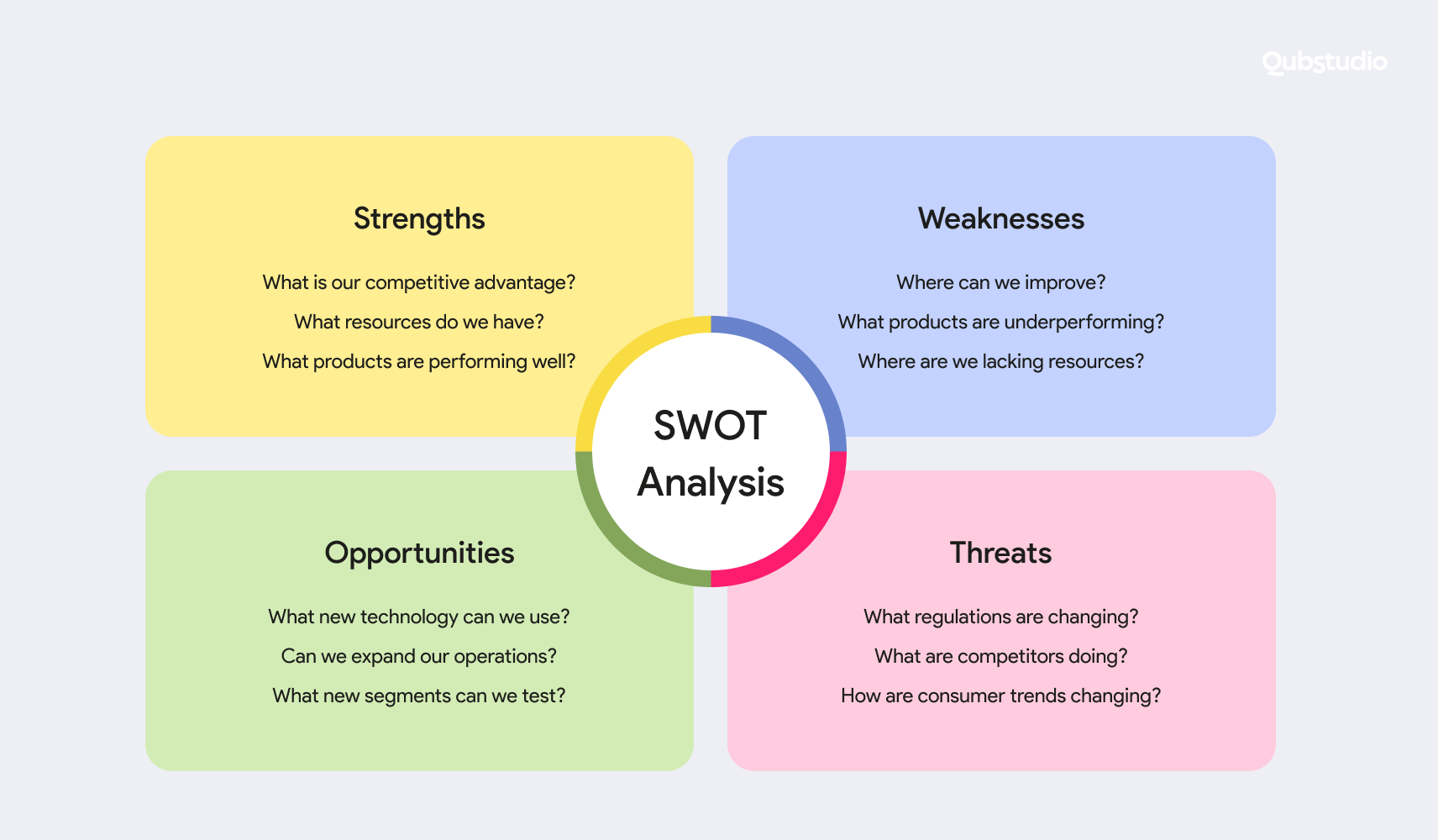
- What are the advantages of your product design? How valuable is the implemented design for the target audience? How easily can you convey this value to consumers? Which user problems does it solve? What indicators can you use to measure the success of your design strategy?
- What are the disadvantages of your product design? Are there ways to improve your design? What does your team need to achieve a better result? What disadvantages does the target audience see in your design?
- How can you promote your product’s design? How easy will it be to promote your product design within the existing market? What are the competitive advantages of your design? What promotion channels are most viable? What are the product’s long-term prospects for success?
- What are the possible barriers to successfully promoting your product’s design? Would the disadvantages of your software solution’s design create notable risks for the product’s promotion? What financial problems might you encounter when promoting your design? Are there any competing products that your product doesn’t easily outperform?
Changing/Modifying Your Product Design
In order to develop product design, you need to follow the above-described product design steps. But as for the alteration of the finished design, you will need to add three important phases beforehand.
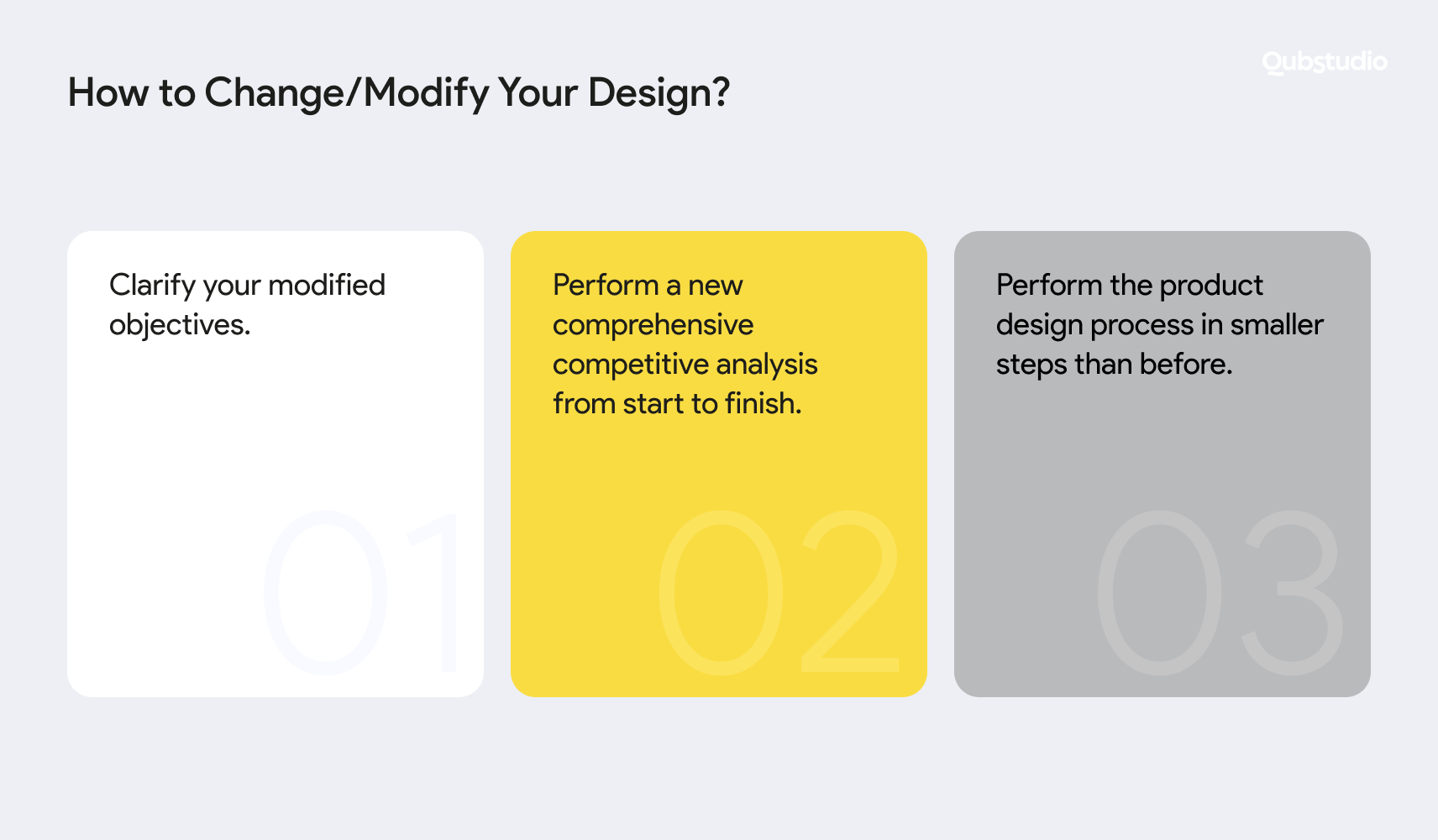
- Step 1: Clarify your modified objectives. For example, when considering a website interface redesign, start by analyzing current metrics like traffic, conversion rates, and user retention. This analysis will tell you what modifications are necessary and steer the product design process.
- Step 2: Perform a new comprehensive competitive analysis from start to finish. Identify elements from successful cases that resonate with audiences similar to yours. Assess not just the competing products but also their estimated budgets; at times, adjusting the design strategy to outpace competitors might exceed your anticipated earnings.
- Step 3: Perform the product design process in smaller steps than before. Experiment by tweaking aspects of the existing design and observing user reactions. Then assess if modifications would result in matching or surpassing the effectiveness of creating an entirely new design. This approach allows you to make informed decisions about the scale and direction of modifications.
Mistakes to Avoid
The design process is complex and error-prone. Let’s discuss what mistakes teams often make when implementing a UX/UI design for a new product.
- Compromising between aesthetics and functionality. Ideal product design is one that combines useful functions and positive aesthetics. If, at the planning stage, you understand that by paying tribute to design trends, you risk making the product unnecessarily difficult/underperforming/too expensive for the target audience, elect to use the proven solutions.
- Breaking the deadlines. When setting the deadlines, try to take into account all the possible delays and force majeure situations, which would entail breaking the timeframes. Otherwise, you put yourself at risk of delivering a “raw” project with an unfinished design.
- Operating upon inaccurate project documentation. Working on the basis of insufficiently scrupulous technical specifications, performers often create products that do not meet customer expectations. Keep in mind the saying: “It’s better to ask again a hundred times than to redo a hundred times”.
- Infringing on intellectual property. This concerns mainly the visual component of your software product design. Carefully ensure that your design team doesn’t borrow easily discernible ideas from other projects. Not only do you put your product in danger of completely failing in the marketplace, but it can also result in costly litigation.
- Lacking ideas for future marketing efforts. Before going through all the stages in the product design process, you need to have a definite idea of what channels and tools you are going to use to promote it to the public (usually, this is the responsibility of marketers, with whom you need to discuss this point in advance). This will help you to come to a timely understanding of the ways of demonstrating the product’s benefits to the customers.
- Failing to follow today’s trends and innovations in your business niche. It is probably difficult to find a consumer who would not want to get the most modern, most innovative product. Therefore, the neglect of market trends in the future can turn into a complete failure of the product when it is presented to the target audience.
- Reluctance to seek help from outside experts. In an attempt to cut costs, product owners often assign the design of a new product to specialists who lack the necessary experience. However, this approach is fundamentally flawed. Rather than subjecting your team members to on-the-job learning, which can be slow and susceptible to errors, it’s often better to pay more and turn to contractors with expertise in product design for your specific field. Prioritizing experienced contractors ensures proficient execution aligned with your project’s requirements.
How to Improve Your Design Process
And now, some simple recommendations for improving your new digital product design process:
- Study your customers thoroughly. To precisely chart a path for the product design process, thoroughly analyze the intended audience; never overlook user research or creating detailed customer profiles. Put yourself in your customer’s shoes and mirror their behaviors. User research and mirroring your customers offer valuable insights, allowing you to gauge the accuracy of your assumptions.
- Do not be afraid of problems. Make problem-solving a team challenge. Postponing or overlooking issues, focusing only on easy tasks, often leads to redoing work. Tackle the toughest challenges early in the product design process when your team’s motivation and enthusiasm are highest. This proactive approach ensures more effective problem resolution and prevents potential setbacks down the line.
- Plan your budget to the maximum. Never underestimate the possible expenses. Otherwise, you risk finishing only some parts of the project and leaving the rest “until better times”.
Finding the Design Solution
For a truly exceptional, contemporary, and distinctive design, engage with seasoned professionals. While your ideas might seem visually appealing in theory, practical execution is vital to meet the expectations of your target audience. Without professional input, you risk investing time and money in a product that won’t prove viable or resonate in the market.
Whatever design idea you have, don’t hesitate to reach out to Qubstudio’s UX/UI professionals.
Product Design with Qubstudio
For over a decade, Qubstudio has been building distinctive design solutions. To develop creative designs, rather than generic solutions, we structure the design process in the following way:
- Ideate. During the ideation stage, we conduct user and market research to validate our ideas, define the product, and build a prototype.
- Create and launch. This phase encompasses activities like UX/UI implementation, UX writing, and launch strategy preparation.
- Grow and scale. In this stage, we provide services like UX/UI audits, product redesign, design process consultancy, and design team augmentation.
Please review our portfolio of finished projects. Among them are:
- Gulf Bank — a leading Kuwaiti bank. We cooperated with the Gulf Bank digital team to rethink and recreate the mobile banking app according to the best practices of customer-centricity.
- BluePallet — an end-to-end industrial commerce platform, pioneering solutions for search, logistics, transactions, and everything in between. We helped Bluepallet to redesign the product and embrace innovative features.
- Ila Bank — the first digital bank in Bahrain. ila Bank sought assistance from Qubstudio to enhance its digital product and adapt it to the bank’s expanding reach. We helped them achieve this goal through a non-standard approach to design implementation.
Conclusion
Creating a UX/UI design for a new product is a complex, multi-step process that requires diverse expertise. To secure a leading market position, it’s critical to partner with seasoned professionals.
Reach out to us, and we’ll help you formulate a reliable design strategy and roll out a successful product.

